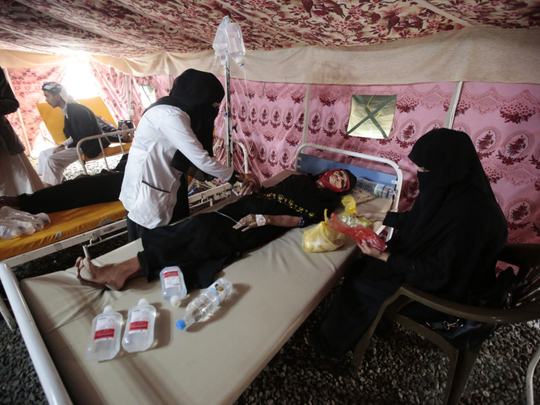
HAJA, Yemen: The Yemeni farm labourer was picking crops in a hot field when the call came. His children, all seven of them, had fallen gravely ill.
Some were vomiting, others had diarrhoea, and all were listless, indicating that they had fallen victim to the latest disaster to afflict this impoverished corner of the Arabian Peninsula: one of the worst outbreaks of cholera infection in recent times.
The labourer, Abdulla Siraa, set about frantically trying to raise money to treat the children — $240 (Dh890), or about six times what he typically earns in a month — and raced as fast as he could on the 30 miles home over roads virtually destroyed in Yemen’s civil war.
“I spent the whole journey reciting Quranic verses and praying for the survival of my children,” he said.
But when he arrived, he learnt that his 4-year-old daughter, Ghadeer, had already died, after hours of calling out for him, though the rest of his children would survive.
For much of the world, cholera, a bacterial infection spread by water contaminated with faeces, has been relegated to the history books. In the 19th century, it claimed tens of millions of lives across the world, mainly through dehydration and electrolyte imbalance.
That ended with modern sanitation and water systems. When it pops up now, it is usually treated easily with rehydration solutions and, if severe, with antibiotics.
But the war currently battering Yemen has damaged infrastructure and deepened poverty, allowing the disease to come roaring back. Cholera is also on the rise in the Horn of Africa because of long-simmering conflicts there. Yemen’s African neighbours, Somalia, South Sudan, Ethiopia and Kenya, have had a total of about 96,000 cholera cases since 2014, international aid groups say.
The crises in Africa, however, pale in comparison to the one in Yemen.
Since a severe outbreak began in late April, according to Unicef, cholera has spread to 21 of the country’s 22 provinces, infecting at least 269,608 people and killing at least 1,614. That is more than the total number of cholera deaths reported to the World Health Organisation worldwide in 2015.
Yemen’s conflict began when Iran-backed Shiite rebels known as the Al Houthis took over the capital, Sana’a, in 2014, later toppling the government. In response, Saudi Arabia and other Arab countries launched an air campaign against the rebels with support from the United States in March 2015.
The campaign has so far not been able to reinstall the internationally recognised president, Abd Rabbo Mansour Hadi in Sana’a, but the fighting have killed more than 8,000 people and displaced at least 3 million, the United Nations says.
From October, Al Houthis have been unable to pay civil servants, prompting strikes from sanitation workers and leading to garbage pileups and septic backups. That contaminated the wells that many Yemenis rely on for water, providing the ideal environment for cholera to spread. The outbreak picked up speed in April, after dirty rainwater further polluted the wells.
Not everyone who is exposed to cholera will contract the disease. But in places like Yemen, where more than 14 million of Yemen’s 27 million people lack access to clean water and 17 million do not have enough food, people are far more vulnerable — particularly malnourished children.
“The average person lives on tea and bread. It’s just one meal a day,” said Jamie McGoldrick, the UN humanitarian coordinator for Yemen. “They are in a weakened state, and that is why they are getting sick.”
Making matters worse, the war has damaged 65 per cent of Yemen’s medical facilities, denying more than 14 million people access to health care.
The extent of the crisis was clear during a recent trip through some of Yemen’s hardest hit areas, where clinics are overburdened and short on supplies, and families struggle to reach them and pay for treatment. Some watch their relatives suffer and die.
Before the war, Yemen was already the Arab world’s poorest nation, and its people never enjoyed high-quality infrastructure. But travel by car, the only means available, has become far more difficult because the infrastructure is shattered with hardly any motorable road or bridges.
A simple 20-mile ride that would have taken an hour before the war is now a maze of complex routes that can take many more hours and cost more than what many families live on for an entire month.
To pay for rides to the hospital, many families borrow money or sell heirloom gold — the equivalent of an American family liquidating retirement accounts. Some who cannot pay carry their loved ones through the rugged terrain on trips that can aggravate dehydration.
Cholera medications are supposed to be freely provided by Yemen’s two competing administrations, but both have favoured their military efforts over public health, forcing many families to buy medications from private pharmacies. Acute cases also require families to buy diapers or carry their infected relatives to the toilet several times an hour.
Siraa, the farm labourer, spoke of his family’s tragedy at a school that a local philanthropist had turned into a clinic in Haja province, which has been hit hard by the cholera epidemic and the war.
The bridge connecting it to the rest of Yemen was destroyed in an air strike last year. The clinic has 35 beds, but only a couple of IV fluid bags, two fans and four nurses.
When asked about his trip to the clinic, his family’s illness and the death of his daughter, Siraa was almost speechless.
“Thank God for everything,” he said. “We Yemenis don’t like to complain because we believe that God punishes complainers.”
Others had suffered through similar ordeals.
“We are too poor for a taxi. We had to walk,” said Saif Ahmad, an unemployed labourer, who stood nearby, wet and dishevelled.
To reach the clinic, a converted school, he and his wife had hiked through a valley known for dangerous flash floods. He had his cholera-infected son on his back.
“It took us five hours to get here. Now we have to beg for money,” Ahmad said. His son, 7, lay on a bed receiving treatment, his mouth agape and his eyes half shut.
The epidemic has also taxed medical workers, who often work in dirty clinics with resources that fall far short of their suffering patients’ needs. They sometimes have to ask their patients’ families to help them clean the floors and bathrooms in their facilities.
“It is not a nice thing to ask someone to do, but we can’t do everything,” said Abdulla Abu Fas, a doctor in the port city of Hodeida. “We can’t work with the smell of faeces and flies everywhere.”
The United Nations says it needs $2.1 billion for its work in Yemen this year, but it has received only 29 per cent of that amount despite repeated pleas for donations from aid groups.
Cultural issues have also aggravated the crisis, said McGoldrick, the UN coordinator. Many Yemenis do not seek help immediately after they show symptoms because “they just don’t want to admit that they have cholera, because they think it makes them look dirty or poor,” he said.
Although the epidemic has hit Yemen’s poor the hardest, it has spread among other classes as well. Aziz Ramadan, a Yemeni Coast Guard officer from Hodeida, nearly lost his wife to cholera last month.
The mother of Ahmad Saif Hashid, a member of Yemen’s Parliament, died of cholera last week, he wrote on his Facebook page.
While more medicine and better treatment would help control the epidemic, Ramadan said, it will very likely continue as long as the war does.
“People will continue to get sick, and they will always be treated like cattle here,” he said. “The international community should just make people stop fighting and help our hospitals.”












